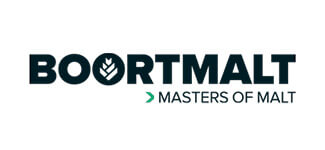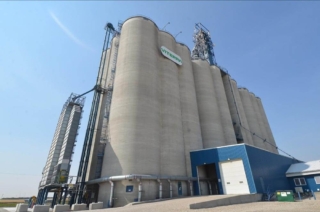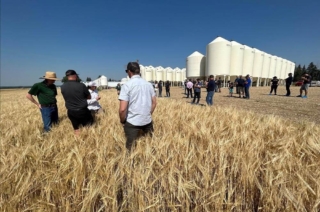CMBTC 2023 Western Canada Barley Tour
The CMBTC’s 2023 Malt Barley New Crop Tour was a success with stunning weather and a diverse agenda including stops at three grain farms, a feedlot, a barley breeding centre, a grain elevator, two micro malt plants and two microbreweries. The tour was based out of Calgary, Alberta, with over 40 participants travelling central and southern Alberta and enjoying “epic conversations” (according to one participant) about Canada’s malting, feed and seed barley industries. This well-rounded Alberta visit was capped off with 15 participants touring the Port of Vancouver by boat to see grain company terminal elevator facilities on August 18th.
During the crop tour, participants had the opportunity to learn about the development and production of malting barley varieties in Canada, from breeding through registration and pedigreed seed production, how to grow malting barley to optimize quality and output, and the opportunity to see Canada’s world-class farming operations. The group saw existing malting barley varieties being grown commercially, including CDC Copeland and AAC Synergy, as well as new varieties AAC Connect, CDC Fraser and CDC Churchill.
The international tour group had participants from four continents: North and South America, Europe, and Asia; representing: Agriculture & Agri-Food Canada, Alberta Grains, Boortmalt, Brown-Foreman, Canterra Seeds, Cargill, Dalian Xingze Malting Co., Yancheng Hyaline Malting Company, FP Genetics, the Japanese Calgary Consulate, Malteurop, Olds College, Richardson International, SeCan, SaskBarley, the Saskatchewan Government, Viterra, and ZoomAgri. For those unable to join us, read on to learn about the tour.
Tour Highlights
Hamill Farms Penhold, Alberta
John Hamill walked the group through their AAC Connect and CDC Churchill barley fields. Although the growing season started out drier than expected, yield potential was anticipated to be between 75-90 bushels per acre. Harvest was expected to begin on Monday, August 21st. John highlighted the good agronomics (yield, standability) and disease packages of these newer malt barley varieties.
Olds College – Field Crop Development Centre (OC-FCDC) Lacombe, Alberta
Yadeta Kabeta, OC-FCDC feed and malt barley breeder, along with Lori Oatway, OC-FCDC grain quality research scientist, gave the group a sneak peek at advanced malt barley lines and the collab trials to help the group visualize the process of barley breeding through testing and registration with the Canadian Food Inspection Agency.
Sheri Strydhorst, who coordinates the Alberta provincial Regional Variety Trials, which evaluate the agronomics of new cereal varieties after registration, gave the group a visual of the farmer perspective of growing different malt barley varieties. Based on 2022 average provincial yields and a barley price of $8 per bushel, AC Metcalfe at 60 bushels/acre resulted in $480/acre of revenue for Alberta farmers. By comparison, AAC Synergy yielded 81 bu/acre or $648/acre of revenue. New varieties like CDC Churchill produced a yield of 89 bu/acre. These basic economics demonstrated why Prairie farmers are switching to new barley genetics.
Niemela’s Sandy Hill Seed Farm Sylvan Lake, Alberta
Next, the group paid a short visit to Niemela’s pedigreed seed farm near Sylvan Lake, where they are growing CDC Fraser and CDC Churchill barley varieties. Tracy Niemela explained they recently switched to growing these new varieties due to great yields and standability. The group also got a small glimpse into the infrastructure investments made by Pedigreed Seed growers to ensure that commercial farmers have access to the seeds of high quality and pure varieties for production of Canadian feed and malt barley. The field of CDC Fraser overlooked striking views of the Alberta foothills.
Hilton Farms Strathmore, Alberta
Spencer Hilton wowed the group with the unique opportunity to see harvest in action. Participants were up close and personal with a John Deere combine, harvesting malt barley and blowing straw and chaff over the soil to feed and foster the 2024 crop. Spencer gave a firsthand account of his family’s pioneering practices to conserve soil and water. In 2023, their zero tillage practices produced a 75 bu/ac CDC Copeland malt barley crop on only 3 inches (76 mm) of rain. With only a third of normal rainfall, the Hilton’s soil health practices of returning straw and chaff to the soil, along with the latest seeding technologies, showed the group conservation and innovation were hard at work on this fast-paced stop.
Origin Malting and Brewing Co. Strathmore, Alberta
The next generation of the Hilton family, Kyle Geeraert, shared his entrepreneurial spirit as the group toured this malt house and brewery that processes CDC Copeland barley from Hilton farms. Local brews and a hearty meal allowed the group to experience Alberta’s rural hospitality.
Bruce Farms Wheatland County, Alberta
As a unique twist to the traditional malt barley tour, the group was given the opportunity to see (and smell) how feed barley is used in Alberta. Sonny Warrick walked the group through corrals of their 12,000-head feedlot, where this family-run farm is making ends meet in the tight margin beef industry. In addition to the feedlot, the family also grows AAC Synergy barley, which can be sold for either malt barley or used as feed in their operations. With 75% of Canada’s barley used in the feed sector either domestically or in export markets, this visit provided the group with an understanding of the scope and scale of Alberta’s feeding sector, which is the largest single market for Canadian barley, using over 3 million tonnes annually.
Viterra Elevator Indus, Alberta
Grain handling logistics are a key to an effective industry. At this stop, Viterra staff showed participants the grading room where things like dockage, protein and moisture are measured on farm delivered grain. Some of the group then suited up in bright orange Personal Protective Equipment or PPE and got the opportunity to see the inner workings of the grain elevator and the beginning of the rail journey that barley takes from the Canadian Prairies en route to international markets.
Newman Farms Blackie, Alberta
At the final stop, the group experienced the essence of an Alberta family farm. Roy Newman, a CMBTC board member, and his wife Robyn are fifth generation farmers. In between harvesting fields of CDC Copeland and CDC Fraser malt barley, the Newman farm showed the group hospitality in the Alberta sunshine, on the shady deck of their family home. One international guest even got to take the combine for a ‘dry run’ on the surrounding field.
Port Tour Vancouver, British Colombia
For some participants, the 2023 crop tour concluded on Friday in the port of Vancouver with a boat tour of the terminal elevators. Participants saw the major terminals of Pacifica (Viterra), Cascadia (Viterra, Richardson), the Cargill and Richardson elevators, as well as the Alliance Grain Terminal and G3. Altogether, the Port of Vancouver exports over 35 million tonnes of grain and oilseeds annually to international markets, and the vast majority of Canada’s barley exports move through these terminals.
Hosted by:


























































































